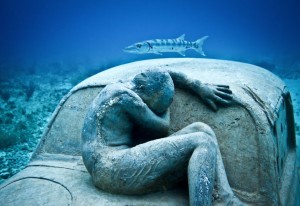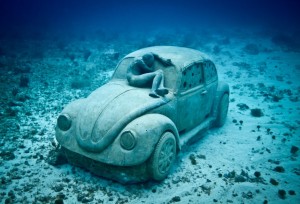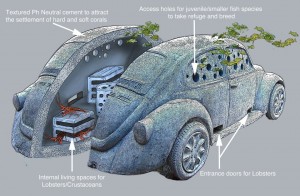Last week, Lee led us through an exercise that helped to contextualize the minuteness of the period in which humans (and modern life on Earth) have existed. Dovetailing off of Haraway’s talk on the Anthropocene (or perhaps Capitaloscene) and her use of visual media and aesthetics to conceptualize and re-conceptualize the term’s significance, this week we will be exploring various aesthetic and artistic interpretations of the Anthropocene (although many of the images may not be constructed by self-proclaimed ‘artists’). There are some interesting works here, as well as in Making the Geologic Now, which we briefly focused on at the beginning of the semester.
I’d like to draw attention to the living sculptures of Jason deCaires Taylor, an artist and coral reef advocate based out of Cancun, Mexico. Opposing the capitalist “land as commodity” paradigm, Taylor subverts the resource-as-value mentality by installing art pieces, whose inherent value to humans is not economic, but artistic, that actively proliferate life on their structures. Taylor’s sculptures, which are composed of ph-neutral, environmentally friendly materials, are not just an interpretation of the world, that is a medium for-us, but rather an artwork acknowledging our large-scale presence that also seeks to heal the world’s depleting reefs – a medium for-them.
With scientists estimating that 80% or more of all reefs on Earth will be lost by 2050, Taylor aims to decouple us from the notion that it is our vulnerability at stake in the Anthropocene. Yes, as Nigel Clark argues, we can succumb to this inhuman nature that is entirely indifferent to preserving our lives, but as Taylor wishes to show, so are the coral reefs. In Taylor’s piece intitled Anthropocene, an old VW bug is submerged on the ocean floor supporting a fossilized child who appears to be asleep. The sculpture is hollow with various openings close to the floor, allowing lobsters to make their homes in the structure. I wonder if these crustaceans symbolize the ancient beginnings of life.
In another piece entitled The Silent Evolution for which he received critical acclaim, Taylor took casts of over 400 humans and installed them in an area over 420 square meters in size. While this underwater society appears human at first, it is imperceptibly transformed into a marine assemblage until it is no longer familiar to us. Taylor’s installations remind us of our simultaneous vulnerability (ala Clark) and our unique human qualities, like our capacity to both destroy life and to engender it. As an aesthetic medium, we are invited to explore the ocean floor and discover these strange objects that evolve over time. Almost a kind of wild Banksy, Taylor plays off of our land-evolved eyesight, drawing our attention to the new ways that light refracts, and colors/perspectives appear underwater.



To add to Emil’s post, I took a look at the piece called “What is the Exponential” in Making the Geologic Now. It can be viewed here:
http://geologicnow.com/7_Denizen.php
I was drawn to this chapter of Making the Geologic Now since I’m fascinated by the idea of the Anthropocene as a period of acceleration. Many parameters in the Anthropocene have taken the expontneital growth, “hockey stick” shape including atmospheric CO2 and global temperatures. I’ve already proposed the idea that the Anthropocene is better viewed as a boundary between geologic time periods rather than a period itself, which I think is supported by the idea of runaway acceleration.
This piece is a montage of various exponential curves. I noticed that the image online is too low-resolution to read the titles and axes. I wonder if this was intentional? Maybe the point is only to evoke a general feeling of exponential growth rather than getting lost in the details?
On a somewhat different note, I was intrigued by this piece since I wasn’t sure whether it really is considered “art”. The Anthropocene debate seems to be blurring the distinctions between mediums, and it is both interesting and exciting to see pieces like this one.